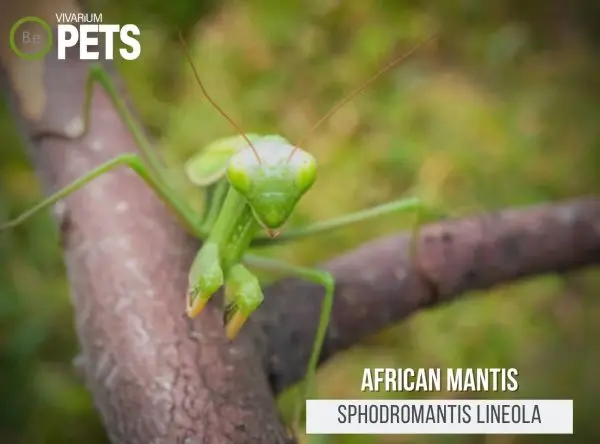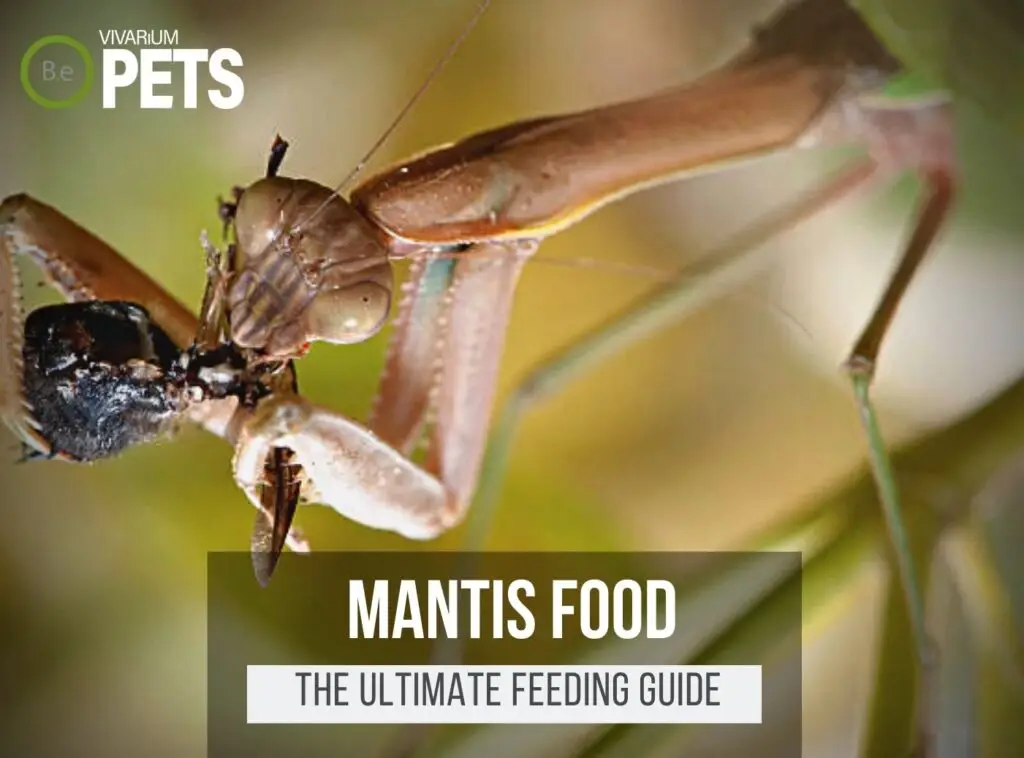Africa is well known for its gigantic variations of critter species we would normally find in much smaller sizes throughout the rest of the world and the African Mantis is no different.
This fascinatingly large species of praying mantis is known for its bright colors and intriguing behavior.
In this guide, you’ll learn all the essential tips and tricks for setting up an ideal habitat and taking care of Sphodromantis lineola.
We’ll look at things like temperature requirements, humidity levels, feeding and handling techniques, shedding tips, and breeding in captivity.
Read on and find out how to give your African Mantis pet the best care possible!
Table Of Contents:
ToggleWhat Is An African Mantis?
Sphodromantis lineola is a large species of mantis belonging to the family Mantidae and is also known by the common name African Praying Mantis.
These brightly colored mantises are native to parts of Africa and are characterized by their long raptorial front legs which are used to catch their prey.
The common name of “praying mantis” comes from their characteristic stance of folding their forelimbs under their head as if in prayer.
African Mantis are found in a variety of habitats and can range in size from a few inches, depending on age and gender.
What Does African Mantis Look Like?
Sphodromantis lineola is known for its striking colors and shape, making it a highly sought-after species for mantid enthusiasts.
The adult mantis is typically a light shade of green and yellow, with a brownish hue along the front part of the wings.
The abdomen has distinctive bands and a pattern of light or dark spots.
African mantis have larger legs and heads when compared to other species, with the female being larger than the male.
The adult mantis is typically between 3 and 4 inches in length. It has a triangle-shaped head with large eyes.
Their antennae are long and thin which helps them to navigate their environment.
The legs are adapted for flexibility and sprawl outwards as the mantis moves.
The wings of the adult mantis have distinct venation with a white stripe at the top and an orange stripe at the bottom.
The wings of a male African mantis will remain folded over the abdomen while the wings of a female will usually be spread out.
Benefits Of Using African Mantis
African Mantis makes an excellent pet for many types of vivariums!
They are relatively easy to care for and can provide a fascinating and dynamic addition to your enclosure.
They are primarily carnivorous and feed on live insects, which can help to keep your miniature ecosystem in balance.
Furthermore, they are quite interesting to watch, as they are very active and display some unique and interesting behaviors.
They make an excellent conversation piece for any terrarium enthusiast.

African Mantis Facts
Sphodromantis lineola is an insect of the family Mantidae, native to sub-Saharan Africa.
They are renowned for their bright colors and active hunting habits and can reach up to several inches in length.
They feed on a variety of invertebrates and have a very territorial personality.
African mantises typically live around a year and breed in the warmer months of the year.
Habitat
Sphodromantis lineola is native to Sub-Saharan Africa, from Egypt to South Africa.
They are commonly found in areas of dense vegetation, including meadows, fields, and around streams or ponds where they can disguise themselves in the foliage.
These mantids usually feed on small bugs and insects, but they can be incredibly opportunistic and feed on larger prey if it’s available.
Create the perfect home for your mantis with our Customizable Mantis Enclosure Kits, designed to meet all their habitat needs.
Diet
In their native habitat, African Mantis are primarily predators, feasting on other insects such as flies, mosquitoes, and moths.
They will also feed on larger prey items such as lizards, amphibians, and even small birds.
Generally, Sphodromantis lineola will only feed on prey that can fit within their grasp, and they hunt using their large raptorial forelegs and excellent eyesight.
Temperament
African Mantis are generally peaceful and calm when around humans and other animals.
They prefer to be left alone rather than handled, so if you do decide to try and handle them it should be done cautiously.
S. lineola have a mildly defensive nature as they can react to perceived threats.
They have the potential to bite if they feel threatened, although it is rare for this to happen.
These mantids are also known to be curious so may react out of curiosity when they see another animal or human.
It is a good habit to take appropriate safety measures when handling them and to move slowly and cautiously around them to prevent startling them.
Lifespan
African Mantis typically have lifespans of 6–12 months, depending on the conditions they’re kept in.
They have multiple stages of development: egg, nymph, sub-adult, and adult.
After hatching from their eggs, mantis nymphs enter the first instar stage of growth.
As they develop, they begin to shed their skin to grow, which is known as “molting.”
For up to five instars, the nymphs will molt, which means they will grow in size and maturity.
Their last instar is the adult form when they are fully mature and in their pre-flying stage. After reaching adulthood, the mantis has only a few weeks to live.
It is during this time they will reproduce and search for a mate. Having mated, they will lay their eggs and die soon after.
Breeding
Sphodromantis lineola mating and reproduction are quite fascinating to observe.
The mating ritual for this species of mantis is quite interesting as the female mantis will usually attack the male during courtship, biting off his head or wings.
This behavior is thought to be a way for the female mantis to assess the male’s future as a mate.
Once accepted, the male then proceeds to transfer his sperm to the female.
The female will then lay eggs a few days later inside an egg pouch called an ootheca.
The female will then hang this ootheca on a plant or other suitable surface to protect the eggs until they hatch.
Once the eggs have hatched, the young mantids emerge as nymphs and are ready to fend for themselves with no parental care.
They will soon reach adulthood and start the process again.
Where To Find African Mantis
Sphodromantis lineola can be found in the wild in a variety of places in Africa such as Cameroon, Nigeria, Ethiopia, and Kenya.
However, finding them in the wild can be quite a challenge.
A better option would be to purchase them from an exotic pet store.
Be sure to thoroughly research the source to ensure they are selling healthy animals with the correct paperwork.
It is essential to pay attention to shipping and handling methods to avoid any unnecessary stress on the mantis.
Furthermore, if you are purchasing African Mantis from wild habitats, choose specimens that are in the best condition with minimal damage to ensure a better chance of survival.
African Mantis Care
To properly care for Sphodromantis lineola you need to create the ideal environment with appropriate temperature and humidity levels, develop safe feeding and handling techniques, understand shedding needs, and try your hand at breeding in captivity.
By following these guidelines, you will be able to provide the care your African Mantis needs to stay healthy and active predators.
Tank Requirements
When it comes to ideal tank requirements for S. lineola, the best vivarium type to choose is a terrestrial enclosure with a screen lid.
This will allow for ample ventilation and help prevent humidity from building up.
The ideal pH for the tank’s water should be between 7 and 8, and the ideal hardness should be between 3 and 8 dH.
Temperature-wise, a good temperature should be between 68°F and 79°F.
For the terrarium soil, you can use a mixture of peat moss, coco coir, and shredded forest bark.
As for terrarium lighting, the enclosure should receive indirect natural light for 12 hours out of the day.
What Do African Mantis Eat?
Feeding your Sphodromantis lineola is one of the most important parts of keeping them at their peak.
When it comes to food, they’re quite versatile and can accept a wide variety of food items, including crickets, flies, grasshoppers, mealworms, wax moth larvae, houseflies, fruit flies, butterflies, dragonflies, mantids, and moths.
When feeding your African Mantis, try to offer at least 2 or 3 different types of food items at a time to ensure they get the nutrition and variety they need.
To give your pet mantis the best nutrition possible, provide them with high-protein feeder insects that are properly supplemented and treated with minerals and vitamins before offering them to your mantis.
Avoid feeder insects that have been collected outdoors, as they may contain contaminants and parasites that could be harmful to your mantis.
Additionally, always thoroughly wash any fruit or vegetable items you intend to offer your mantis, as these can often contain harmful pesticides.
Properly fed African Mantis should be fed 3-4 times per week, depending on the growth rate.
Offer as much as your mantis can eat, typically 1-2 prey items per day.
If you notice any uneaten food after a few hours, you can remove it so it doesn’t contaminate the enclosure.
If you’re looking for a more detailed approach to feeding these critters, be sure to check out my ultimate DIY Praying Mantis food guide. I give a more in-depth explanation of the best foods and my favorite recipe.
Best Tankmates For African Mantis
Due to the predatory nature of Sphodromantis lineola, it should be the only species in a given habitat.
However, some other beneficial animals can be kept with them in the same habitat to provide an even better environment for the mantis.
Some good tankmates include non-predatory insects such as crickets, flies, and cockroaches; spiders such as jumping spiders; and small lizards such as geckos or skinks.
These animals can help to create a more natural and stimulating environment, and they can also help to keep the African Mantis well-fed with natural prey.
Be sure to choose animals that have similar requirements in terms of temperature and humidity, and keep an eye on them to make sure they don’t make meals out of your mantis.
Conclusion
Congratulations! You now know all the tips and tricks for giving your Sphodromantis lineola the best possible care and setting up the best possible habitat.
With the right environment and handling techniques, you can look forward to enjoying many years of fascinating observation of your African Mantis.
Create the ideal habitat for your praying mantis with our species-specific soil mixes and Insect Enclosure Kits. These products provide everything you need for a thriving Mantid habitat.
Frequently Asked Questions
African Mantis (Sphodromantis lineola) typically reach up to 3 to 4 inches in length.
African mantis (Sphodromantis lineola) can live around 6 to 12 months in captivity.
The African mantis species is Sphodromantis lineola, a species of praying mantis native to Sub–Saharan Africa.





